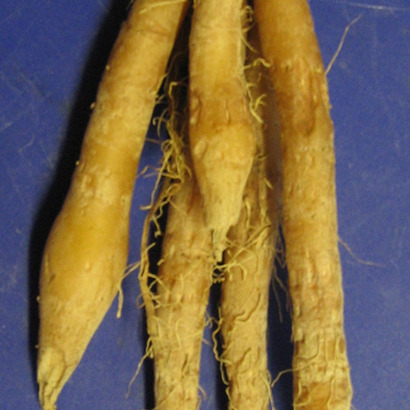Plants to 50 cm. Rhizomes bright yellow, ovoid-globose, strongly aromatic; roots robust. Leaves 3 or 4; leaf sheath red; ligule 2-cleft, ca. 5 mm; petiole 7--16 cm, channeled; leaf blade green on both surfaces, ovate-oblong or elliptic-lanceolate, 25--50 × 7--12 cm, glabrous except for sparsely hairy midvein abaxially, base rounded to cuneate, apex apiculate. Inflorescences terminal on pseudostems, appearing from within apical leaf sheaths, subsessile, 3--7 cm; bracts lanceolate, 4--5 cm. Flowers aromatic. Calyx 1.5--2 cm, apex 2-cleft. Corolla pink; corolla tube 4.5--5.5 cm; lobes oblong, 1.5--2 cm. Lateral staminodes light pink, obovate, ca. 1.5 cm. Labellum white or pink with purple stripe, fiddle-shaped, 2.5--3.5 cm, concave, margin slightly crisped, apex entire. Filament short; connective appendage reflexed, 2-cleft, 1--3 mm. Fl. Jul--Aug. 2 n = 36*.
More
A part of the ginger family. The plant continues to grow from year to year. The plant is 30-50 cm high. The roots are like a long orange brown group of fingers. These rhizomes are the size of fingers. They are 6-10 cm long and 1 cm wide. Inside the brown skin is a yellow sweet smelling tissue. The leaves occur as 3-4 leaves 10-30-50 cm long by 5-10 cm wide. The leaf stalk is 5-12 cm long and has a channel. The leaf sheath is red. The flowers are at the ends of the stalk. There are few flowers surrounded by narrow bracts. Each bract 5 cm long surrounds one flower. The flowers are white or pink. The flowers have a smell. The fruit is oval.
It is a tropical plant. In colder regions, leaves will die back in winter. They need a fertile, open, loamy soil. The soil need to be well drained. They shoot best with warmth and humidity. They then grow best in warm shady positions. They need a rainfall of 1000 mm per year. In China it grows in dense forests at about 1000 m in S China. In Cairns Botanical Gardens.
More
Dense forests at elevations around 1,000 metres in southern China. Mixed deciduous and evergreen forests, on limestone hills along streams, from sea-level up to elevations of 1,200 metres.
The swollen rhizomes are eaten raw, used in soups along with vegetables, and in fish curries. In some places the leaves are used in pickles. The roots give a spicy flavour to many dishes. The rhizome is used to spice food. The very young leaves are sometimes used as a spice.


